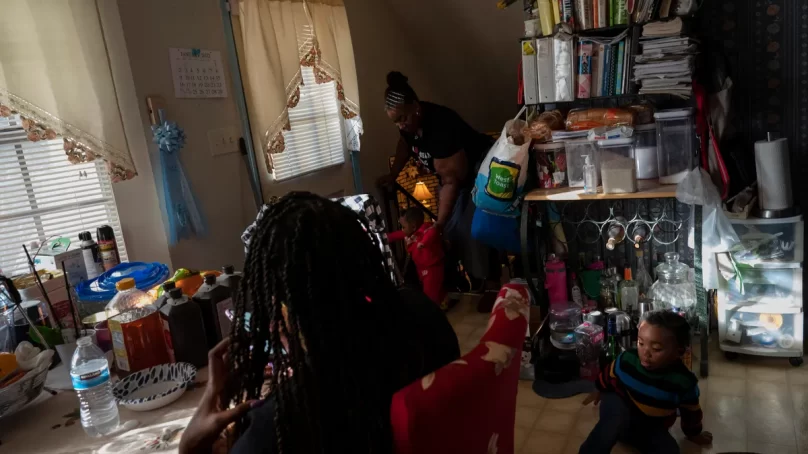
To fully understand maternal mortality and infant mortality crises for Black women and babies in the United States, the nation must first reckon with the dark history of how gynaecology began.
According to Deirdre Cooper Owens, a historian and author, negligence that is informed biases stretching centuries back to slavery era plays a part.
“The history of this particular medical branch … it begins on a slave farm in Alabama,” Owens said. “The advancement of obstetrics and gynaecology had such an intimate relationship with slavery, and was literally built on the wounds of Black women.”
Reproductive surgeries that were experimental at the time, like caesarean sections, were commonly performed on enslaved Black women.
Physicians like the once-heralded J. Marion Sims, an Alabama doctor many call the “father of gynaecology,” performed torturous surgical experiments on enslaved Black women in the 1840s without anaesthesia.
Maternal sepsis is a leading cause of maternal mortality in America. Black women are twice as likely to develop severe maternal sepsis compared to their white counterparts, research shows.
Common symptoms can include fever or pain in the area of infection. Sepsis can develop quickly, so a timely response is crucial.
Sepsis in its early stages can mirror common pregnancy symptoms, so it can be hard to diagnose. Due to a lack of training, some medical providers don’t know what to look for. But slow or missed diagnoses are also the result of bias, structural racism in medicine and inattentive care that leads to patients, particularly Black women, not being heard.
“The way structural racism can play out in this particular disease is not being taken seriously,” said Dr Laura Riley, chief of obstetrics and gynaecology at Weill Cornell Medicine and New York-Presbyterian Hospital. “We know that delay in diagnosis is what leads to these really bad outcomes.”
In the days and weeks that followed, Angelica demanded explanations from the medical staff of what happened. But she felt the answers she received on how it occurred were sparse and confusing.
A spokesperson for the University of Alabama at Birmingham said in a statement that they couldn’t talk about Angelica’s case because of patient privacy laws. They pointed to a recent internal survey done by its Obstetrics and Gynaecology department that showed that most of its patients are satisfied with their care and “are largely feeling respected,” and said the university and hospital “maintain intentional, proactive efforts in addressing health disparities and maternal mortality.”
Angelica’s son, Malik, was born eight weeks early, weighing under five pounds. He spent a month in intensive care. He received home visits through the first year of life to monitor his growth. While he’s now a curious and vivacious three-year-old who loves to explore the world around him, Angelica recalls those days in the ICU and she feels guilty because she could not be with him.
“It’s scary to know I could have died, that we could have died,” Lyons said, wiping away tears.
For decades, frustrated birth advocates and medical professionals have tried to sound an alarm about the ways medicine has failed Black women. Historians trace that maltreatment to racist medical practices that Black people endured amid and after slavery.
And well after the abolition of slavery, hospitals performed unnecessary hysterectomies on Black women, and eugenics programmes sterilised them. Health care segregation also played a major role in the racial health gap still experienced today.
Until Congress passed the Civil Rights Act of 1964, Black families were mostly barred from well-funded white hospitals and often received limited, poor or inhumane medical treatment. Black-led clinics and doctors worked hard to fill in the gaps, but even after the new protections, hospitals once reserved for Black families remained under-resourced, and Black women didn’t get the same support regularly available for white women.
That history of abuse and neglect led to deep-rooted distrust of health care institutions among communities of colour.
“We have to recognise that it’s not about just some racist people or a few bad actors,” said Rana A. Hogarth, an associate professor of History at the University of Illinois, Urbana-Champaign. “People need to stop thinking about things like slavery and racism as just these features that happened that are part of the contours of history and maybe think of them more as foundational and institutions that have been with us every step of the way.”
Some healthcare providers still hold false beliefs about biological differences between Black and white people, such as Black people having “less sensitive nerve endings, thicker skin, and stronger bones.” Those beliefs have caused medical providers today to rate Black patients’ pain lower, and recommend less relief.
The differences exist regardless of education or income level. Black women who have a college education or higher have a pregnancy-related mortality rate that is more than five times higher than that of white women. Notably, the pregnancy-related mortality rate for Black women with a college education is 1.6. times higher than that of white women with less than a high school degree.
In Angelica Lyons’ home state of Alabama, about 40 mothers die within one year after delivery. The toll on Black mothers is disproportionate.
The state’s infant mortality rate for 2021 was 7.6 deaths per 1,000 live births. The disparities between Black and white babies is stark: The infant mortality rate in 2021 for white mothers was 5.8, while the infant mortality rate for Black mothers was 12.1, an increase from 10.9 from the prior year.
Black babies account for just 29 per cent of births in Alabama, yet nearly 47 per cent of infant deaths. A 2020 report by the Alabama Maternal Mortality Review Committee found that more than 55 per cent of 80 pregnancy-related deaths that they reviewed in 2016 and 2017 could have been prevented.
Alabama launched its Maternal Mortality Review Committee in 2018 to investigate maternal deaths. But Dr Scott Harris, Alabama’s Department of Public Health State Health Officer, said work remains to collect a fuller picture of why the disparities exist.
“We certainly know that from national numbers as well that Black women have worse maternal outcomes at every income level, which is pretty startling,” said Dr Harris. “Age matters and just overall ZIP code matters. Unfortunately, where people live, where these children are born, is strongly associated with infant mortality. I think we’ll see something similar for maternal outcomes.”
And concerns about access and barriers to care remain.
- An AP report











